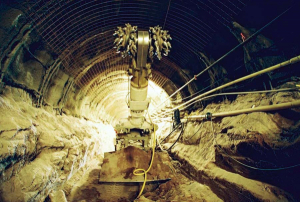In Mining, Safety is Crucial
Blades on a large heavy metal circular ball spin at a high rate of motion against hard, metamorphic rocks, causing crushed rock, dirt and, possibly, dangerous levels of invisible methane gas to form. Pressure and speed are adjusted by the person controlling the machine with joysticks and buttons, but this isn’t your next-generation gaming console.
This is reality 200 feet below ground in a coal mine. The machine: a roadheader.
The roadheader is equipped with tools that grab the rocks and place them on a conveyor before they are sent out of the mine for processing, before ultimately being burned to produce electricity, cement, or even steel.
Although the cliché “safety first” is said in just about every work environment, it has to be the standard in coal mining, where people are hundreds of feet below ground in a hazardous environment.
KFG Electric Systems in Poland knows this. KFG engineered and installed a modern underground coal mining control system in Poland that could be used anywhere in Europe with the latest safety features for many of the major mining companies, including protection against methane.
Methane is a big concern for coal miners as it releases naturally during coal extraction. For years, canaries were used in mines to detect high methane levels. They could not survive in slightly lower than dangerous methane levels for humans. When the bird stopped chirping, miners knew to flee. For at least four decades, thanks to modern detectors worn by every miner, methane is detected without killing birds.
The controls enclosure that is on the backside of the roadheader measures 1,700 x 700 x 600 mm with a weight of 1,200 kg (2,400 lbs), making it rock-solid in an underground mine. It is equipped with a safety Rockwell Automation® Compact GuardLogix 43S, a POINT I/O™ safety adapter, and a regular POINT I/O adapter. A safety PAC is used for safety-specific instructions, security, and safety I/O.
KFG needed to communicate from the Rockwell Automation system that natively speaks EtherNet/IP™ to protection relays, EX IOs, and other devices that speak the Modbus® language.
The operation uses several specialized Modbus® devices from different vendors. Because of this, they needed a gateway with multiple ports. ProSoft Technology’s gateway has four Modbus ports and is fast with up to 4000 words in 5ms.
KFG chose ProSoft Technology’s EtherNet/IP to Modbus Gateway to communicate from the controller to the protection relays and other remote Modbus devices.
“We didn’t want to be beta testers and use a device made by a one-person company,” said Marcin Ptaszny, CEO of KFG Electric Systems. “It was key to have long-term support and availability of the device.”
They wanted a proven solution, so they chose ProSoft Technology. Protection relays sense when there could be trouble via an electrical overload and relay the information to the PAC quickly to shut off the system.
Port 1 of the gateway is connected to an RTU Master and communicates with overcurrent protectors. Port 2 is connected to a RTU Slave that is used for the remote radio control system that allows the miner to control the roadheader from a safe distance. Port 3 is connected to an RTU Master and explosion-safe distributed IO system. Port 4 is connected to an RTU slave and communicates to a surface SCADA system.
ProSoft’s gateway was easy to configure, diagnose, and implement.
“This is why the customer loves the Add-On Profile and Add-On Instruction we delivered,” Mr. Ptaszny said. “They are pleased with the implementation of the EtherNet/IP to Modbus gateway, specifically the IO connection allowing really fast data exchange with the IOs and the remote joystick in the roadheader.”
Mining is the kind of market that does not implement technological changes quickly. KFG is one of the first companies in the world designing new mining systems this way, using safety IO and a GuardLogix safety controller communicating with numerous protection relays and EX IOs.



